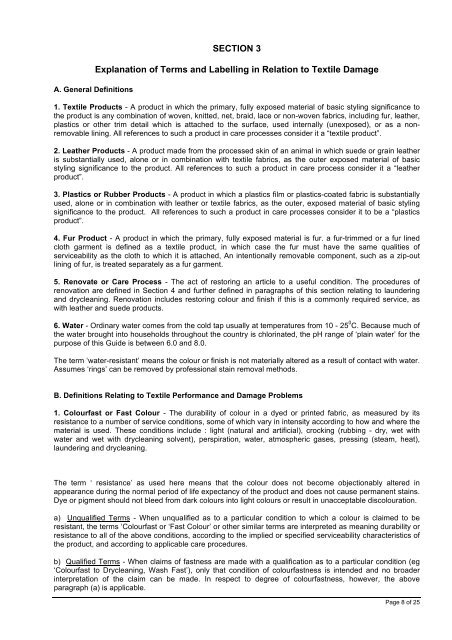international fair claims guide for consumer textiles products
international fair claims guide for consumer textiles products
international fair claims guide for consumer textiles products
Create successful ePaper yourself
Turn your PDF publications into a flip-book with our unique Google optimized e-Paper software.
A. General Definitions<br />
SECTION 3<br />
Explanation of Terms and Labelling in Relation to Textile Damage<br />
1. Textile Products - A product in which the primary, fully exposed material of basic styling significance to<br />
the product is any combination of woven, knitted, net, braid, lace or non-woven fabrics, including fur, leather,<br />
plastics or other trim detail which is attached to the surface, used internally (unexposed), or as a nonremovable<br />
lining. All references to such a product in care processes consider it a “textile product”.<br />
2. Leather Products - A product made from the processed skin of an animal in which suede or grain leather<br />
is substantially used, alone or in combination with textile fabrics, as the outer exposed material of basic<br />
styling significance to the product. All references to such a product in care process consider it a “leather<br />
product”.<br />
3. Plastics or Rubber Products - A product in which a plastics film or plastics-coated fabric is substantially<br />
used, alone or in combination with leather or textile fabrics, as the outer, exposed material of basic styling<br />
significance to the product. All references to such a product in care processes consider it to be a “plastics<br />
product”.<br />
4. Fur Product - A product in which the primary, fully exposed material is fur. a fur-trimmed or a fur lined<br />
cloth garment is defined as a textile product, in which case the fur must have the same qualities of<br />
serviceability as the cloth to which it is attached, An intentionally removable component, such as a zip-out<br />
lining of fur, is treated separately as a fur garment.<br />
5. Renovate or Care Process - The act of restoring an article to a useful condition. The procedures of<br />
renovation are defined in Section 4 and further defined in paragraphs of this section relating to laundering<br />
and drycleaning. Renovation includes restoring colour and finish if this is a commonly required service, as<br />
with leather and suede <strong>products</strong>.<br />
6. Water - Ordinary water comes from the cold tap usually at temperatures from 10 - 25 0 C. Because much of<br />
the water brought into households throughout the country is chlorinated, the pH range of ‘plain water’ <strong>for</strong> the<br />
purpose of this Guide is between 6.0 and 8.0.<br />
The term ‘water-resistant’ means the colour or finish is not materially altered as a result of contact with water.<br />
Assumes ‘rings’ can be removed by professional stain removal methods.<br />
B. Definitions Relating to Textile Per<strong>for</strong>mance and Damage Problems<br />
1. Colourfast or Fast Colour - The durability of colour in a dyed or printed fabric, as measured by its<br />
resistance to a number of service conditions, some of which vary in intensity according to how and where the<br />
material is used. These conditions include : light (natural and artificial), crocking (rubbing - dry, wet with<br />
water and wet with drycleaning solvent), perspiration, water, atmospheric gases, pressing (steam, heat),<br />
laundering and drycleaning.<br />
The term ‘ resistance’ as used here means that the colour does not become objectionably altered in<br />
appearance during the normal period of life expectancy of the product and does not cause permanent stains.<br />
Dye or pigment should not bleed from dark colours into light colours or result in unacceptable discolouration.<br />
a) Unqualified Terms - When unqualified as to a particular condition to which a colour is claimed to be<br />
resistant, the terms ‘Colourfast or ‘Fast Colour’ or other similar terms are interpreted as meaning durability or<br />
resistance to all of the above conditions, according to the implied or specified serviceability characteristics of<br />
the product, and according to applicable care procedures.<br />
b) Qualified Terms - When <strong>claims</strong> of fastness are made with a qualification as to a particular condition (eg<br />
‘Colourfast to Drycleaning, Wash Fast’), only that condition of colourfastness is intended and no broader<br />
interpretation of the claim can be made. In respect to degree of colourfastness, however, the above<br />
paragraph (a) is applicable.<br />
Page 8 of 25


